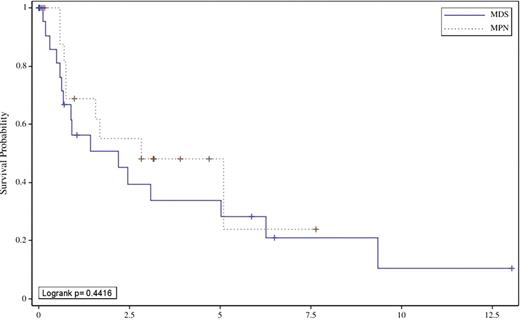Abstract
Abstract 4238
Duplication of the long arm of chromosome 1 (1q) is a recurrent finding in hematologic neoplasms. It is most commonly observed as an unbalanced whole arm translocation with chromosome 7, resulting in concurrent deletion of 7q (ISCN as der(1;7)(q10q10)). It is less frequently observed as an unbalanced translocation with a chromosome other than chromosome 7 or as a duplication of only a segment of 1q. The der(1;7) has been described in myelodysplastic syndrome (MDS), and acute myeloid leukemia (AML), and is reportedly less commonly associated with myeloproliferative neoplasms (MPN). The effect of this rearrangement on prognosis is unclear, although it is classified by the International Scoring System (IPSS) as a karyotypic variant of del(7q)/-7 and is thus assigned poor risk. We have initiated a thorough review of all cases of duplication of the long arm of chromosome 1 seen at our institution.
After approval from the Institutional Review Board, all cases seen at Mayo Clinic over a 20 year period (1989-2009) were searched for a duplication of the long arm of chromosome 1. The sole exclusion criterion was a complex karyotype (3 or more independent chromosome abnormalities in the clone). Cytogenetic and hematopathology review was done and relevant clinical data were abstracted from the Mayo Clinic record. Survival of MDS patients and MPN patients was determined from time of cytogenetic diagnosis of der(1;7) until death or last contact with the patient, using the Kaplan-Meier method.
Among 23,375 unique patients at Mayo Clinic with a cytogenetic study for hematologic neoplasm, 229 (0.98%) patients carried a duplication of 1q. Within this group, 99 (0.42%) had duplication of part of 1q, 123 (0.53%) carried a whole arm duplication of 1q, and 7 patients carried an isochromosome 1q (resulting in 4 copies of 1q). The most common karyotype among those with a whole arm duplication of 1q was der(1;7) (n=84), followed by similar whole arm translocations involving chromosomes 9 and 19 (n=7 each) or chromosomes 12, 13, 14, 15, 16, 17, 18, 20, 21, or 22 (n=1 to 6 each). We focused on 65 der(1;7) patients who had adequate hematopathological material that could be reviewed and sub-classified according to WHO criteria. MDS was identified in 30 patients and MPN in 20. MDS (therapy related, RARS, RAEB-1 or 2) was seen in 9 patients (14%), MDS/ refractory cytopenia with multilineage dysplasia (RCMD) in 19 (29%). MDS/Myeloproliferative neoplasm (MPN) in 2 (3%), MPN not otherwise classified in 5 (8%), and MPN / primary myelofibrosis (including 1 post-polycythemic and one post-thromobocythemic) (PMF) in 15 (23%). The bone marrow was apparently normal in 5 patients (8%), CLL was noted in 3 (5%), and 1 each exhibited features of systemic mast cell disease or myeloma. Acute myeloid leukemia (AML) was identified 5 patients (8%). The M:F ratio of the der(1;7) patients was 2.8:1. The median age at occurrence of the der(1;7) was 63 years (range: 13-87 years). All 5 AML patients have died (median survival 9 months). Of the MDS and MPN patients, the median survival was 2.2 and 2.8 years, respectively, from the time of cytogenetic diagnosis. Overall survival was not significantly different between the MDS and MPN group, and they exhibited 30% survival after 5 years (see Figure).
Duplication of 1q was observed in nearly 1% of the Mayo Clinic patients who had a bone marrow cytogenetic study for a hematologic neoplasm. Among those with a der(1;7), AML was uncommon but MDS and MPN were similar in frequency. Median survival of 2.2 to 2.8 years for the MDS and MPN group justifies assignment to a more favorable group than the current IPSS assignment.
No relevant conflicts of interest to declare.
Author notes
Asterisk with author names denotes non-ASH members.


This feature is available to Subscribers Only
Sign In or Create an Account Close Modal